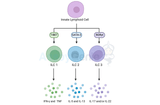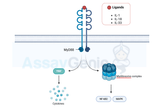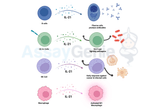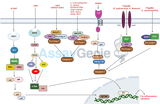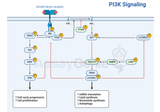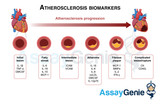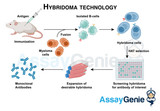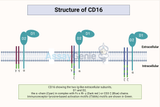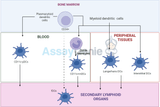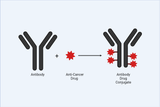Blog
Innate Lymphoid Cells Differentiation: Guardians of Immune Homeostasis
Innate Lymphoid Cells (ILCs) represent a fascinating component of the immune system, playing a crucial role in maintaining tissue homeostasis and mounting rapid responses against pathogens. These cells lack antigen-specific receptors, distinguishing them from their adaptive counterparts, yet their ability to rapidly respond to environmental cues is vital for effective immune surveillance. One of the key aspects of ILCs' functionality lies in their differentiation process, a complex series of events that shape these cells into distinct subsets with specialized functions. Understanding ILC Differentiation: ILCs are broadly categorized into three main subsets based on their cy
…
2nd Feb 2024
IL-1 Family Signaling: Unraveling the Molecular Orchestra of Immune Regulation
The Interleukin-1 (IL-1) family represents a crucial group of signaling molecules that play a pivotal role in regulating the immune system and inflammatory responses. Comprising 11 members, including IL-1α, IL-1β, IL-18, and IL-33, the IL-1 family members exhibit diverse functions in immune homeostasis, tissue repair, and disease pathogenesis. In this article, we will delve into the intricate details of the IL-1 family signaling pathway, shedding light on its components, activation mechanisms, and physiological significance. Components of the IL-1 Family Signaling Pathway: IL-1 Receptors (IL-1Rs): The IL-1 family signaling cascade begins with the binding of
…
2nd Feb 2024
The role of IL-18 in health and disease
Exploring IL-18: A key cytokine in inflammation and disease. Key Takeaways: IL-18, a pro-inflammatory cytokine, plays a pivotal role in immune responses, particularly in inducing Type II interferon and activating macrophages. It's produced as an inactive form and activated by caspase-1, signaling through IL-18 receptors to trigger inflammation. IL-18's regulation involves IL-18 binding protein (IL-18BP) and IL-37, which modulate its activity and prevent excessive inflammation. It contributes to T cell differentiation and NK cell cytotoxicity, influencing various immune functions. IL-18 is implicated in several diseases, including Crohn's disease and sepsis, making it a potential
…
1st Feb 2024
IL-9 Signaling and Its Impact on Immune Cell Regulation
Interleukin-9 (IL-9) plays a critical role in the immune system, influencing a variety of biological functions across different immune cell types. This article provides an in-depth look at the signaling mechanisms of IL-9 and its widespread effects on immune regulation, specifically focusing on its impact on T cells, mast cells, basophils, B cells, and regulatory T cells (Tregs). IL-9 Signaling Pathway Overview of IL-9 Receptor Activation IL-9 interacts with the IL-9 receptor (IL-9R), composed of the IL-9Rα chain and the common gamma chain (γc), initiating the JAK-STAT signaling cascade. This activation promotes the transcription of genes that regulate cell proliferation, d
…
1st Feb 2024
The Intricacies of IL-21 Signaling: Impact on Diverse Immune Cell Types
Interleukin-21 (IL-21) stands out as a pivotal cytokine in the complex network of immune system communication. Its role in regulating various immune cell types has drawn considerable attention from researchers seeking to unravel the intricate web of signaling pathways and biological effects it elicits. In this article, we will delve into the nuanced world of IL-21 signaling and explore its profound impacts on different immune cell populations. IL-21: An Overview IL-21 belongs to the family of cytokines, which are small proteins crucial for intercellular communication. Produced mainly by activated CD4+ T cells, particularly T follicular helper (Tfh) cells and Th17 cells, IL-
…
31st Jan 2024
Nod-Like Receptor Signaling Pathway: A Keystone in Innate Immunity
The innate immune system, a primary line of defense against pathogens, comprises various cellular and molecular mechanisms. Among these, the Nod-like Receptor (NLR) signaling pathways play a critical role. They are central to the immune response, acting as intracellular sensors of pathogen-associated molecular patterns (PAMPs) and danger-associated molecular patterns (DAMPs). This article delves into the basic components of NLR signaling pathways, their key steps, roles in development, and implications in disease. Basic Components of Nod-Like Receptor Signaling Pathways: Nod-like receptors (NLRs) belong to the pattern recognition receptor (PRR) family and are primarily located in
…
30th Jan 2024
Decoding the Language of Cells: Chemokine Signaling Pathways Unveiled
Chemokines are small signaling proteins that play a crucial role in the immune system by directing the movement of cells, orchestrating immune responses, and maintaining tissue homeostasis. The intricate network of chemokine signaling pathways governs the trafficking and positioning of immune cells throughout the body, contributing to various physiological and pathological processes. This article aims to delve into the complexity of chemokine signaling pathways, shedding light on their diverse functions and significance in cellular communication. Chemokines and Their Receptors: Chemokines belong to a family of chemotactic cytokines that guide the migration of immune cells b
…
28th Jan 2024
Biomarkers & Inflammatory markers of atherosclerosis
As atherosclerosis is a complex inflammatory disease, there are many influential biomarkers that contribute to the disease’s progression as well as biomarkers from atherosclerosis related diseases such as periodontal disease and autoimmune diseases i.e. Diabetes, RA, SLE. Biomarkers can be proteins, DNA and mRNA which are measured to asses biological, pathological processes and pharmacological responses. Biomarkers can be classified as early, predictive and prognostic biomarkers depending on disease stage (Huang et al., 2010). Identifying biomarkers for disease and finding therapeutic targets is crucial to research and treatment and overall a populations mortality and morbidity rat
…
23rd Jan 2024
Hybridoma Technology: Revolutionizing Antibody Production
Hybridoma technology, a revolutionary method in immunology pioneered by Georges Köhler and César Milstein in the 1970s, has transformed the landscape of antibody production. This groundbreaking technique has had a profound impact on various scientific domains, from diagnostics to therapeutics and basic research. In this essay, we explore the intricacies of hybridoma technology, its diverse applications, and its pivotal role in advancing our understanding and treatment of diseases. The Birth of Hybridoma Technology: The genesis of hybridoma technology lies in the fusion of two distinct cell types: B cells, responsible for antibody production, and myeloma cells, which possess the a
…
23rd Jan 2024
CD25 Marker
CD25, a key molecule in immune regulation, is integral to the function of activated lymphocytes and regulatory T cells. It's central in mediating immune responses, with implications in autoimmune diseases and cancer. Key Takeaways: CD25, part of the IL-2 receptor, is crucial in immune response regulation. Found on T cells, NK cells, Tregs, and others; upregulated during immune activation. Vital for cellular immune responses and maintaining immune homeostasis. Serves as a biomarker in autoimmune diseases, allergies, and certain cancers. Targeted in immunotherapy for diseases like multiple sclerosis and various cancers. What is CD25? CD25, also known as Cluster o
…
22nd Jan 2024
MAPK Signaling in Inflammatory Cytokines Pathways
The Mitogen-Activated Protein Kinase (MAPK) pathway is a pivotal signaling cascade that plays a crucial role in mediating cellular responses to various external stimuli. This pathway is intricately involved in the regulation of inflammatory cytokines, key signaling molecules in the immune system. Understanding the MAPK signaling pathway in the context of inflammatory cytokines is essential for grasping the molecular basis of inflammation and its related disorders. Overview of MAPK Signaling Fundamental Components and Activation: MAPK signaling encompasses a series of protein kinases that transmit signals from the cell surface to the nucleus. These kinases include the Extrac
…
22nd Jan 2024
JAK-STAT Signaling Pathway: A Comprehensive Exploration
window.SHOGUN_IMAGE_V2_ELEMENTS = window.SHOGUN_IMAGE_V2_ELEMENTS || new Array();
window.SHOGUN_IMAGE_V2_ELEMENTS.push({ uuid: 's-45124fd5-9a75-444d-b680-b8339e2a814d' })
Progression of the JAK STAT Signalling Pathway Cellular communication is a complex network of molecular interactions that govern various physiological processes. Among the many signaling pathways, the Janus kinase-signal transducer and activator of transcription (JAK-STAT) pathway plays a pivotal role in mediating signals from the cell surface to the nucleus. This pathway is essential for regulating immune responses, cell proliferation, differentiation, and survival. In this article, we will delv
…
18th Jan 2024
Understanding CD16: A Comprehensive Overview
CD16, also known as FcγRIII (Fc gamma receptor III), plays a crucial role in the immune system, serving as a receptor for the Fc region of immunoglobulin G (IgG). This receptor is a key player in mediating various immune responses and has implications in both innate and adaptive immunity. In this article, we will delve into the structure, functions, and significance of CD16 in the context of immune regulation. Key Takeways CD16, also known as FcγRIII, is crucial in both innate and adaptive immunity. There are two isoforms: CD16A on NK cells, macrophages, and neutrophils, and CD16B mainly on neutrophils. Functions include Antibody-Dependent Cellular Cytotoxicity (ADCC),
…
5th Jan 2024
Understanding CD16: A Comprehensive Overview
CD16, also known as FcγRIII (Fc gamma receptor III), plays a crucial role in the immune system, serving as a receptor for the Fc region of immunoglobulin G (IgG). This receptor is a key player in mediating various immune responses and has implications in both innate and adaptive immunity. In this article, we will delve into the structure, functions, and significance of CD16 in the context of immune regulation. Structure of CD16: CD16 is a transmembrane glycoprotein that belongs to the immunoglobulin superfamily. It exists in two main isoforms: CD16A (FcγRIIIA) and CD16B (FcγRIIIB). CD16A is expressed on the surface of natural killer (NK) cells, macrophages, and neutrophils, while
…
5th Jan 2024
Dendritic Cells: Tracing the Developmental Lineage Pathway
Dendritic cells (DCs) are pivotal in the immune system, orchestrating innate and adaptive immune responses. Understanding their developmental lineage pathway is crucial in immunology, particularly in the context of cancer and infection responses. Introduction to Dendritic Cells Dendritic cells are unique antigen-presenting cells (APCs) that play a crucial role in the immune system. They are known for their ability to capture and present antigens, thereby bridging innate and adaptive immunity. DCs are heterogeneous, comprising various subsets with distinct phenotypes and functions. This diversity is a result of their complex developmental lineage. Origin and Early Development
…
5th Jan 2024
Positive Control vs Negative Control
T cell activation is a crucial process in the immune response, playing a pivotal role in how the body responds to pathogens and maintains immune homeostasis. This intricate process involves several key stages and molecules, each contributing to the effective functioning of T cells in the immune system. Understanding the Basics of T Cell Activation Direct conjugation involves the direct covalent attachment of the molecule to the antibody. This method is straightforward but requires careful control of reaction conditions to ensure specificity and retain antibody functionality. Indirect Conjugation Indirect conjugation uses a two-step process. Initially, a reactive group is
…
24th Aug 2023
Antibody Structure: Overview & Insights
Antibody Structure
Antibody Structure, Functions & Isotypes IgG, IgA, IgE, IgM, IgD
window.SHOGUN_IMAGE_ELEMENTS = window.SHOGUN_IMAGE_ELEMENTS || new Array();
window.SHOGUN_IMAGE_ELEMENTS.push({ hoverImage: '', uuid: 's-f48dc466-ae8e-404f-842f-cda508fd128a' })
…
23rd Aug 2023
PCR : Types and Applications
PCR stands as a cornerstone in molecular biology, enabling scientists to magnify and analyze fragments of DNA with incredible precision. In this blog, we'll embark on understanding of PCR – from its fundamental principles to the diverse techniques that have revolutionized research, diagnostics, and beyond. Key Takeaways PCR is a pivotal technique for DNA amplification, crucial in research, diagnostics, and forensics. Variants like Hot Start PCR, RT-PCR, and qPCR enhance specificity, analyze RNA, and quantify nucleic acids. Advances like High Fidelity Polymerase and Digital PCR offer precision in detecting mutations and low-abundance genes. Table of Content
…
23rd Aug 2023
Leukocytes : Basics to Diseases
Only 1% of our blood is made up of white blood cells, but they have a significant impact. Alternatively referred to as leukocytes, white blood cells. We are shielded from disease and illness by them. This blog is an overview of leukocytes including their function, development, types, location and disease.
Table of Contents
Jump to a section:
- Types of Leukocytes
- Production/Development
- Location
- Stimulation
- Function
- Leukocytes and Disease
.nav__list {
list-style: none;
}
.nav__list a{
font-family: Poppins;
font-size: 18px;
color: #29aae1;
}
.nav__list li{
margin-bo
…
22nd Aug 2023
Cystic Fibrosis: Causes, Inheritance, Treatment and Diagnosis
What is Cystic Fibrosis?
Cystic fibrosis (CF) is a genetic disorder that impairs the body's ability to produce sweat and thick mucus. CF causes mucus to build up in the lungs. This mucus clogc the lungs, preventing them from functioning properly. CF can lead to infection, breathing problems and also affect digestion and reproduction. Cystic fibrosis is the most prevalent fatal genetic disease in the United States, affecting about 30,000 Americans. There is currently no cure for cystic fibrosis, but there are several therapies that may help to alleviate symptoms. CF patients are at a higher risk of developing other health problems, such as liver disease, lung
…
22nd Aug 2023
The role of IFN gamma in inflammation, cancer and autoimmune disease
Interferons are key cytokines in the immune system, crucial for combating viral and bacterial infections, with significant roles in both innate and adaptive immunity responses. Key Takeaways Interferons (IFNs) are crucial cytokines in immune responses against viral and bacterial challenges. There are two main types: Type I (IFN-alpha and IFN-beta) and Type II (IFN-gamma), each with unique roles and receptor interactions. IFN-gamma, a Type II interferon, is pivotal in innate and adaptive immunity, produced mainly by T cells and NK cells. What are Interferons? Interferons (IFN) are a family of cytokines which, upon secretion, play a central role in mediating the innate an
…
22nd Aug 2023
CXCL16 – Review
CXCL16
CXCL16, a unique member of the CXC chemokine family, stands at the crossroads of immune modulation and vascular biology. Initially discovered as a chemokine, CXCL16 operates beyond its chemotactic role by serving as a transmembrane protein that can bind to its receptor, CXCR6. This dual functionality endows CXCL16 with the ability to regulate immune cell trafficking, particularly those expressing CXCR6, and to participate in diverse physiological processes such as inflammation, atherosclerosis, and tissue repair. CXCL16's intriguing capacity to bridge immune responses with vascular dynamics underscores its significance as a multifaceted player
…
15th Aug 2023
CXC Chemokine Family
In the realm of immunology, CXCL chemokines emerge as fascinating conductors. These small proteins, marked by their CXC motif, wield considerable influence over our immune responses and a range of physiological processes. Imagine them as precise guides, steering immune cells with accuracy. Yet, their contributions expand further – they also play a pivotal role in tissue repair and hold promise for novel therapies. Embark on this scientific journey as we delve into the captivating world of CXCL chemokines,
{
"@context": "https://schema.org",
"@type": "Article",
"mainEntityOfPage": {
"@type": "WebPage",
"@id": "https://www.assaygenie.com/blog/cxc-chemokine-fami
…
15th Aug 2023
Mechanisms of HIV persistence during HAART
HIV Virus: Replication Cycle and Pathogenesis in absence of HAART
The human immunodeficiency virus (HIV) is a formidable pathogen that has posed a significant global health challenge for decades. Known for its complex replication cycle and ability to evade the immune system, HIV leads to acquired immunodeficiency syndrome (AIDS) if left untreated. Highly Active Antiretroviral Therapy (HAART) has revolutionized the management of HIV, significantly improving the quality of life and life expectancy of individuals living with the virus. However, to fully appreciate the impact of HAART, it's essential to delve into the intricacies of the HIV replication cycle and
…
15th Aug 2023

